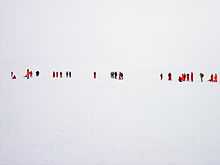Whiteout (weather)



Whiteout is a weather condition in which visibility and contrast are severely reduced by snow or sand. The horizon disappears completely and there are no reference points at all, leaving the individual with a distorted orientation. Whiteout has been defined as: A condition of diffuse light when no shadows are cast, due to a continuous white cloud layer appearing to merge with the white snow surface. No surface irregularities of the snow are visible, but a dark object may be clearly seen. There is no visible horizon. [1]
A whiteout may be due simply to extremely heavy snowfall rates as seen in lake effect conditions, or to other factors such as diffuse lighting from overcast clouds, mist or fog, or a background of snow. People can be lost in their own front yards during a true whiteout, when the door is only 10 feet (3 meters) away, and they would have to feel their way back. Motorists have to stop their cars where they are, as the road is impossible to see. Normal snowfalls and blizzards, where snow is falling at 1 or 2 inches per hour (2.5 or 5.1 cm/h), or where the relief visibility is not clear yet having a clear field of view for over 30 feet (9 meters), are often incorrectly called whiteouts.
Types
There are four different forms of a whiteout:
- In blizzard conditions, snow already on the ground can become windblown, reducing visibility to near zero.
- In snowfall conditions, the volume of snow falling may obscure objects reducing visibility to near zero. This only happens during lake-effect snow, or mountain-effect snow, where the volume of snow can be many times greater than normal snows or blizzards.
- In clear air conditions, when there is little or no snow falling, but the ground is completely covered with snow, diffuse lighting from overcast clouds may cause all surface definition to disappear. It becomes impossible to tell how far away the snowy surface is. In polar regions this optical illusion can make whole snow-covered mountains invisible against the background white cloud, and the horizon cannot be identified, slopes cannot be judged for steepness, and snow surfaces cannot be seen. This effect is exacerbated by a smooth surface of fresh snow. It is only when a contrasting object is placed on a snowy surface that the surface can be detected. In less extreme cases, it may suffice to break the snow surface by throwing a snowball ahead. This form is also known as flat light or sector whiteout.[2][3]
- Where ground-level thick fog exists in a snow-covered environment, especially on open areas devoid of features.
Hazards
Whiteout conditions pose threats to mountain climbers, skiers, aviation, and mobile ground traffic. Motorists, especially those on large high speed routes are also at risk. There have been many major multiple-vehicle collisions associated with whiteout conditions. One motorist may come to a complete stop when he or she cannot see the road, while the motorist behind is still moving.
Local, short-duration whiteout conditions can be created artificially in the vicinity of airports and helipads due to aircraft operations. Snow on the ground can be stirred up by helicopter rotor down-wash or airplane jet blast, presenting hazards to both aircraft and bystanders on the ground.
See also
- Air New Zealand Flight 901, an air accident on Mount Erebus, Antarctica in 1979 caused in part by whiteout conditions.
- Black ice
References
- ↑ The Crossing of Antarctica by Sir Vivian Fuchs and Sir Edmund Hillary (Glossary, page 296) Cassell, London, 1958
- ↑ "General Aviation Pilot’s Guide to Preflight Weather Planning, Weather Self-Briefings, and Weather Decision Making". U.S. Federal Aviation Administration. August 2006.
- ↑ "Aviation Safety Letter 4/2002". Transport Canada Civil Aviation.